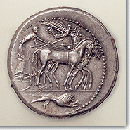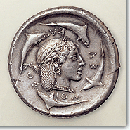


 In 483 B.C., eastern Sicily was under the control of Gelon and Theron tyrant of Acragas, while Himera and Selinus had allied themselves with Carthage and in Messene power was exercised by Anaxilas tyrant of Rhegium. In 482 B.C., however, Theron seized power at Himera and, expelling Terillus, allied himself with Syracuse. Terillus now begged Carthage, with whom Anaxilas also allied himself, to intervene. But the Carthaginian army was crushed by Gelon's forces at Himera. After their defeat the Carthaginians came to terms with Gelon, receiving war damages of two thousand talents and undertaking to build two temples in which copies of the peace treaty would be dedicated. The battle of Himera signalled the consolidation of Gelon's power in Sicily. At the symbolic level, however, it was connected with the repulse of the Persian invasion of Hellas proper, and it contributed to the formation of the concept that the concerted barbarian attack in the east and the west had been repulsed by the Hellenes. This point of view is confirmed by a piece of information in Herodotus: the battle of Himera (he tells us) happened on the same day as the sea battle of Salamis. Gelon's death did not lead to the decline of his state. In 474 B.C. Hieron, his brother and successor, defeated the Etruscans at Cyme, gaining control of the seaways north of the straits of Messene, where, from the date of the sea battle of Alalia (540 B.C.) onwards the Etruscan fleet had been master.
In 483 B.C., eastern Sicily was under the control of Gelon and Theron tyrant of Acragas, while Himera and Selinus had allied themselves with Carthage and in Messene power was exercised by Anaxilas tyrant of Rhegium. In 482 B.C., however, Theron seized power at Himera and, expelling Terillus, allied himself with Syracuse. Terillus now begged Carthage, with whom Anaxilas also allied himself, to intervene. But the Carthaginian army was crushed by Gelon's forces at Himera. After their defeat the Carthaginians came to terms with Gelon, receiving war damages of two thousand talents and undertaking to build two temples in which copies of the peace treaty would be dedicated. The battle of Himera signalled the consolidation of Gelon's power in Sicily. At the symbolic level, however, it was connected with the repulse of the Persian invasion of Hellas proper, and it contributed to the formation of the concept that the concerted barbarian attack in the east and the west had been repulsed by the Hellenes. This point of view is confirmed by a piece of information in Herodotus: the battle of Himera (he tells us) happened on the same day as the sea battle of Salamis. Gelon's death did not lead to the decline of his state. In 474 B.C. Hieron, his brother and successor, defeated the Etruscans at Cyme, gaining control of the seaways north of the straits of Messene, where, from the date of the sea battle of Alalia (540 B.C.) onwards the Etruscan fleet had been master.
|
| |
|
Note: Click on pictures to see a short description. | |